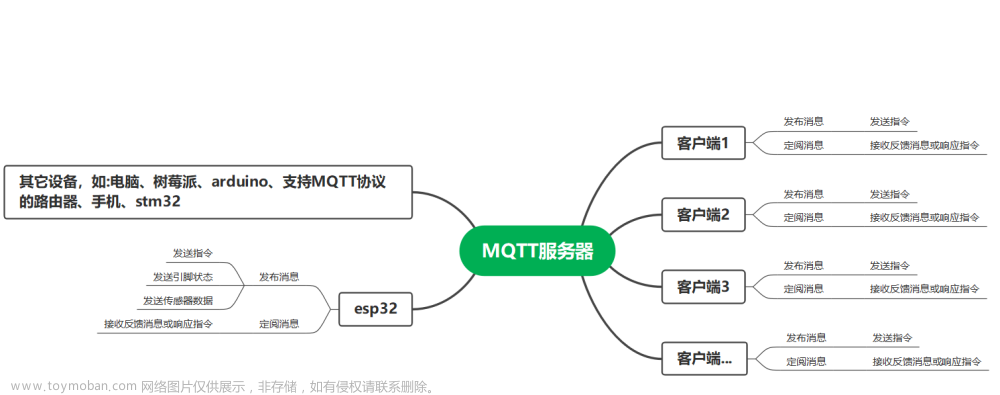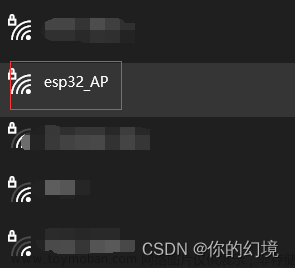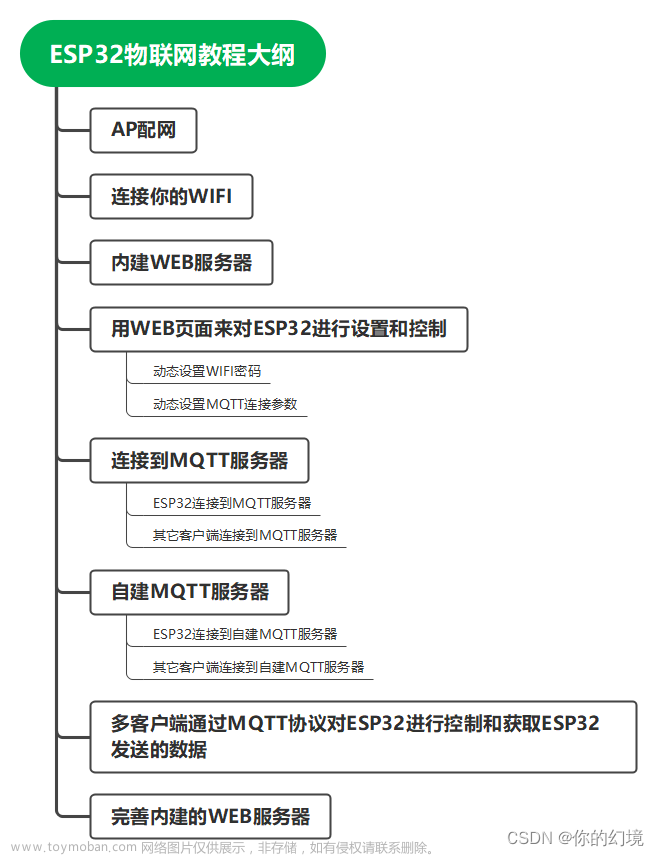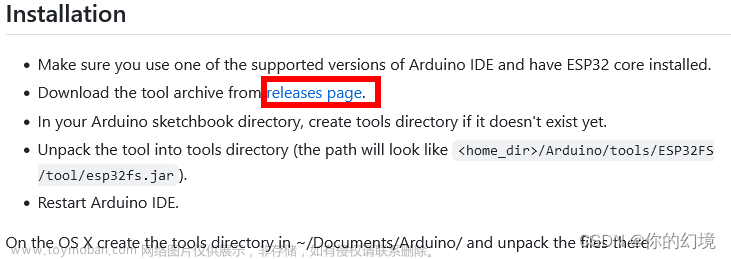最近在使用ESP32搭建web服务器测试,发现esp32搭建这类开发环境还是比较方便的。具体的http协议这里就不再赘述,我们主要说一下如何使用ESP32提供的API来搭建我们的http web。
一、web服务器搭建过程
1、配置web服务器
在ESP-IDF中,Web服务器使用httpd组件实现。我们需要先创建httpd_config_t结构体,指定服务器的端口、最大并发连接数、URI匹配处理器等选项。然后,我们通过调用httpd_start函数来启动Web服务器。(使用默认的配置就可以,包括端口号都已经默认配置好了)
httpd_config_t config = HTTPD_DEFAULT_CONFIG();
httpd_handle_t server = NULL;
// 设置服务器端口为80
config.server_port = 80;
// 创建HTTP服务器句柄
if (httpd_start(&server, &config) != ESP_OK) {
printf("Error starting server!\n");
return;
}
2、 注册 URI处理器
在Web服务器启动后,我们需要为不同的URI注册处理器函数。当Web服务器接收到请求时,会根据请求的URI选择相应的处理器函数进行处理。在ESP-IDF中,我们可以使用httpd_register_uri_handler函数注册URI处理器。该函数的原型如下
esp_err_t httpd_register_uri_handler(httpd_handle_t hd, const httpd_uri_t *uri)
其中,hd参数为HTTP服务器句柄;uri参数为包含URI路径、HTTP方法、处理函数等信息的结构体指针。例如:
static const httpd_uri_t echo = {
.uri = "/",
.method = HTTP_POST,
.handler = echo_post_handler,
.user_ctx = NULL
};
static esp_err_t echo_post_handler(httpd_req_t *req)
{
char buf[100];
// char ssid[10];
// char pswd[10];
int ret, remaining = req->content_len;
while (remaining > 0) {
/* Read the data for the request */
if ((ret = httpd_req_recv(req, buf,
MIN(remaining, sizeof(buf)))) <= 0) {
if (ret == HTTPD_SOCK_ERR_TIMEOUT) {
/* Retry receiving if timeout occurred */
continue;
}
return ESP_FAIL;
}
/* Send back the same data */
httpd_resp_send_chunk(req, buf, ret);
remaining -= ret;
esp_err_t e = httpd_query_key_value(buf,"ssid",wifi_name,sizeof(wifi_name));
if(e == ESP_OK) {
printf("ssid = %s\r\n",wifi_name);
}
else {
printf("error = %d\r\n",e);
}
e = httpd_query_key_value(buf,"password",wifi_password,sizeof(wifi_password));
if(e == ESP_OK) {
printf("pswd = %s\r\n",wifi_password);
}
else {
printf("error = %d\r\n",e);
}
/* Log data received */
ESP_LOGI(TAG, "=========== RECEIVED DATA ==========");
ESP_LOGI(TAG, "%.*s", ret, buf);
ESP_LOGI(TAG, "====================================");
}
// End response
httpd_resp_send_chunk(req, NULL, 0);
if(strcmp(wifi_name ,"\0")!=0 && strcmp(wifi_password,"\0")!=0)
{
xSemaphoreGive(ap_sem);
ESP_LOGI(TAG, "set wifi name and password successfully! goto station mode");
}
return ESP_OK;
}
html的网页如下:这个网页包含了按钮的定义,以及发送json格式的数据。
最后送json数据的时候,要用JSON.stringify方法格式化data,否则esp32解析json会报错,此处一定要注意!!!
整体html界面非常简单,没有基础的也很容易读懂,里面写了一个js函数,该函数是在点击按钮的时候触发,功能主要是读取文本框输入的数据,将数据封装为json格式,然后post发送数据,xhttp.open(“POST”, “/wifi_data”, true);中的url “/wifi_data”和esp32服务端中的定义要一致,否则是无法成功的。
<!DOCTYPE html>
<head>
<meta charset="utf-8">
<title>Web server system</title>
</head>
<table class="fixed" border="5">
<col width="1000px" /><col width="500px" />
<tr><td>
<h2 style=" text-align:center;"> **** Web Server ***</h2>
<h3>wifi 密码配置</h3>
<div>
<label for="name">wifi名称</label>
<input type="text" id="wifi" name="car_name" placeholder="ssid">
<br>
<label for="type">密码</label>
<input type="text" id="code" name="car_type" placeholder="password">
<br>
<button id ="send_WIFI" type="button" onclick="send_wifi()">提交</button>
</div>
</td><td>
<table border="10">
<tr>
<td>
<label for="newfile">Upload a file</label>
</td>
<td colspan="2">
<input id="newfile" type="file" onchange="setpath()" style="width:100%;">
</td>
</tr>
<tr>
<td>
<label for="filepath">Set path on server</label>
</td>
<td>
<input id="filepath" type="text" style="width:100%;">
</td>
<td>
<button id="upload" type="button" onclick="upload()">Upload</button>
</td>
</tr>
</table>
</td></tr>
</table>
<script>
function setpath() {
var default_path = document.getElementById("newfile").files[0].name;
document.getElementById("filepath").value = default_path;
}
function upload() {
var filePath = document.getElementById("filepath").value;
var upload_path = "/upload/" + filePath;
var fileInput = document.getElementById("newfile").files;
/* Max size of an individual file. Make sure this
* value is same as that set in file_server.c */
var MAX_FILE_SIZE = 200*1024;
var MAX_FILE_SIZE_STR = "200KB";
if (fileInput.length == 0) {
alert("No file selected!");
} else if (filePath.length == 0) {
alert("File path on server is not set!");
} else if (filePath.indexOf(' ') >= 0) {
alert("File path on server cannot have spaces!");
} else if (filePath[filePath.length-1] == '/') {
alert("File name not specified after path!");
} else if (fileInput[0].size > 200*1024) {
alert("File size must be less than 200KB!");
} else {
document.getElementById("newfile").disabled = true;
document.getElementById("filepath").disabled = true;
document.getElementById("upload").disabled = true;
var file = fileInput[0];
var xhttp = new XMLHttpRequest();
xhttp.onreadystatechange = function() {
if (xhttp.readyState == 4) {
if (xhttp.status == 200) {
document.open();
document.write(xhttp.responseText);
document.close();
} else if (xhttp.status == 0) {
alert("Server closed the connection abruptly!");
location.reload()
} else {
alert(xhttp.status + " Error!\n" + xhttp.responseText);
location.reload()
}
}
};
xhttp.open("POST", upload_path, true);
xhttp.send(file);
}
}
function send_wifi() {
var input_ssid = document.getElementById("wifi").value;
var input_code = document.getElementById("code").value;
var xhttp = new XMLHttpRequest();
xhttp.open("POST", "/wifi_data", true);
xhttp.onreadystatechange = function() {
if (xhttp.readyState == 4) {
if (xhttp.status == 200) {
console.log(xhttp.responseText);
} else if (xhttp.status == 0) {
alert("Server closed the connection abruptly!");
location.reload()
} else {
alert(xhttp.status + " Error!\n" + xhttp.responseText);
location.reload()
}
}
};
var data = {
"wifi_name":input_ssid,
"wifi_code":input_code
}
xhttp.send(JSON.stringify(data));
}
</script>
static esp_err_t html_default_get_handler(httpd_req_t *req)
{
// /* Send HTML file header */
// httpd_resp_sendstr_chunk(req, "<!DOCTYPE html><html><body>");
/* Get handle to embedded file upload script */
extern const unsigned char upload_script_start[] asm("_binary_upload_script_html_start");
extern const unsigned char upload_script_end[] asm("_binary_upload_script_html_end");
const size_t upload_script_size = (upload_script_end - upload_script_start);
/* Add file upload form and script which on execution sends a POST request to /upload */
httpd_resp_send_chunk(req, (const char *)upload_script_start, upload_script_size);
/* Send remaining chunk of HTML file to complete it */
httpd_resp_sendstr_chunk(req, "</body></html>");
/* Send empty chunk to signal HTTP response completion */
httpd_resp_sendstr_chunk(req, NULL);
return ESP_OK;
}
httpd_uri_t html_default = {
.uri = "/", // Match all URIs of type /path/to/file
.method = HTTP_GET,
.handler = html_default_get_handler,
.user_ctx = "html" // Pass server data as context
};
httpd_register_uri_handler(server, &html_default);这里要特别注意:
1)、.uri = "/",这个表示当你打开网页的IP地址后第一个要显示的页面,也就是要放到根目录下("/"也就是根目录)。
2)、ESP32可以直接将html的网页编译进来不需要转为数组,但在CMakeList.txt文件中需要EMBED_FILES upload_script.html这样的形式引入网页文件。这个html编译出出来的文本文件怎么使用呢。wifi.html编译出来一般名称是默认的_binary_名称_类型_start。这个指针代编译出来文件的起始地址。_binary_名称_类型_end,代表结束地址。wifi.html的引用方式如下。通过以下的方式就可以获得html这个大数组。
extern const unsigned char upload_script_start[] asm("_binary_upload_script_html_start");
extern const unsigned char upload_script_end[] asm("_binary_upload_script_html_end");
const size_t upload_script_size = (upload_script_end - upload_script_start);
/* Add file upload form and script which on execution sends a POST request to /upload */
httpd_resp_send_chunk(req, (const char *)upload_script_start, upload_script_size);
3、实现URI处理函数
在注册URI处理器后,我们需要实现对应的处理器函数。URI处理器函数的原型为:
typedef esp_err_t (*httpd_uri_func_t)(httpd_req_t *req);
如上面示例中的:
static esp_err_t html_default_get_handler(httpd_req_t *req)4、处理HTTP请求
在URI处理器函数中,我们可以通过HTTP请求信息结构体指针httpd_req_t获取HTTP请求的各种参数和数据。以下是一些常用的HTTP请求处理函数:
httpd_req_get_hdr_value_str:获取HTTP请求头中指定字段的值(字符串格式)
httpd_req_get_url_query_str:获取HTTP请求URL中的查询参数(字符串格式)
httpd_query_key_value:解析HTTP请求URL中的查询参数,获取指定参数名的值(字符串格式)
httpd_req_recv:从HTTP请求接收数据
httpd_req_send:发送HTTP响应数据
httpd_resp_set_type:设置HTTP响应内容的MIME类型
httpd_resp_send_chunk:分块发送HTTP响应数据。
例如,以下是一个URI处理器函数的示例,用于处理/echo路径的POST请求:
static esp_err_t echo_post_handler(httpd_req_t *req)
{
char buf[1024];
int ret, remaining = req->content_len;
// 从HTTP请求中接收数据
while (remaining > 0) {
ret = httpd_req_recv(req, buf, MIN(remaining, sizeof(buf)));
if (ret <= 0) {
if (ret == HTTPD_SOCK_ERR_TIMEOUT) {
// 处理超时
httpd_resp_send_408(req);
}
return ESP_FAIL;
}
// 处理接收到的数据
// ...
remaining -= ret;
}
// 发送HTTP响应
httpd_resp_set_type(req, HTTPD_TYPE_TEXT);
httpd_resp_send(req, "Received data: ", -1);
httpd_resp_send_chunk(req, buf, req->content_len);
httpd_resp_send_chunk(req, NULL, 0);
return ESP_OK;
}
5、 发送响应
在URI处理函数中,可以使用httpd_resp_send()函数将响应发送回客户端。该函数需要传入一个httpd_req_t结构体作为参数,该结构体表示HTTP请求和响应。
例如,在上面的hello_get_handler处理函数中,可以使用httpd_resp_send()函数将“Hello, World!”字符串作为响应发送回客户端:
static esp_err_t hello_get_handler(httpd_req_t *req)
{
const char* resp_str = "Hello, World!";
httpd_resp_send(req, resp_str, strlen(resp_str));
return ESP_OK;
}
二、主要使用API的说明
1. httpd_register_uri_handler
用于将HTTP请求的URI路由到处理程序。这个函数接收两个参数:httpd_handle_t类型的HTTP服务器句柄和httpd_uri_t类型的URI配置。
2. httpd_handle_t
httpd_handle_t是HTTP服务器的一个句柄,它是通过httpd_start函数创建的。而httpd_uri_t则定义了HTTP请求的URI信息,包括URI路径、HTTP请求方法和处理函数等。
3. httpd_query_key_value获取变量值
httpd_query_key_value 用于从查询字符串中获取指定键的值。查询字符串是指URL中?后面的部分,包含多个键值对,每个键值对之间使用&分隔。例如,对于以下URL:
http://192.168.1.1/path/to/handler?key1=value1&key2=value2
获取其中的:
esp_err_t httpd_query_key_value(const char *query, const char *key, char *buf, size_t buf_len);
这是一个使用示例
char query_str[] = "key1=value1&key2=value2";
char key[] = "key1";
char value[16];
if (httpd_query_key_value(query_str, key, value, sizeof(value)) == ESP_OK) {
printf("value=%s\n", value);
} else {
printf("key not found\n");
}
4. 获取get参数示例
下面定义的 handler 演示了如何从请求参数里解析 字符串param1和整型变量param2:文章来源:https://www.toymoban.com/news/detail-841965.html
esp_err_t index_handler(httpd_req_t *req)
{
char* query_str = NULL;
char param1_value[10] = {0};
int param2_value=0;
query_str = strstr(req->uri, "?");
if(query_str!=NULL){
query_str ++;
httpd_query_key_value(query_str, "param1", param1_value, sizeof(param1_value));
char param2_str[10] = {0};
httpd_query_key_value(query_str, "param2", param2_str, sizeof(param2_str));
param2_value = atoi(param2_str);
}
char resp_str[50] = {0};
snprintf(resp_str, sizeof(resp_str), "param1=%s, param2=%d", param1_value, param2_value);
httpd_resp_send(req, resp_str, strlen(resp_str));
return ESP_OK;
}
5. 获取post参数示例
下面的示例代码中根据httpd_req_t的content_len来分配一个缓冲区,并解析请求中的POST参数:文章来源地址https://www.toymoban.com/news/detail-841965.html
esp_err_t post_demo_handler(httpd_req_t *req)
{
char post_string[64];
int post_int=0;
if (req->content_len > 0)
{
// 从请求体中读取POST参数
char *buf = malloc(req->content_len + 1);
int ret = httpd_req_recv(req, buf, req->content_len);
if (ret <= 0)
{
// 接收数据出错
free(buf);
return ESP_FAIL;
}
buf[req->content_len] = '\0';
// 解析POST参数
char *param_str;
param_str = strtok(buf, "&");
while (param_str != NULL)
{
char *value_str = strchr(param_str, '=');
if (value_str != NULL)
{
*value_str++ = '\0';
if (strcmp(param_str, "post_string") == 0)
{
strncpy(post_string, value_str, sizeof(post_string));
}
else if (strcmp(param_str, "post_int") == 0)
{
post_int = atoi(value_str);
}
}
param_str = strtok(NULL, "&");
}
free(buf);
}
// 将结果打印输出
printf("post_string=%s, post_int=%d\n", post_string, post_int);
// 返回成功
httpd_resp_send(req, NULL, 0);
return ESP_OK;
}
httpd_uri_t post_uri = {
.uri = "/post",
.method = HTTP_POST,
.handler = post_demo_handler,
.user_ctx = NULL
};
到了这里,关于ESP32系列四:搭建http的webserver的服务器的文章就介绍完了。如果您还想了解更多内容,请在右上角搜索TOY模板网以前的文章或继续浏览下面的相关文章,希望大家以后多多支持TOY模板网!














